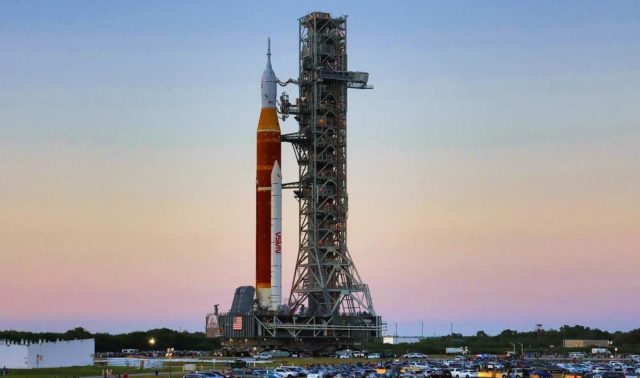
NASA to hold off retest of Artemis, clearing way for Axiom Space civilian launch At Kennedy Space Center, Fla., NASA’s moon rocket for the Artemis 1 mission rolls to the launch pad, March 17, 2022. (Joe Burbank/Orlando Sentinel/TNS)
NASA will stand down for now in its attempt to complete a launch pad test of the massive Artemis moon rocket at Kennedy Space Center, which paves the way for the first all-civilian launch to the International Space Station on Friday.
After scrubs in the tanking and countdown simulation on both Sunday and Monday at KSC’s Launch Pad 39-B, further attempts this week would have threatened the Axiom Space launch on a SpaceX Crew Dragon from nearby Launch Pad 39-A.
But NASA officials said a quick turnaround wasn’t in the cards to work out the issues from the incomplete test.
“It looks like we’ll take just about as much time as we’re going to need for Axiom to fly, so we will fall in behind them,” said Artemis mission manager Mike Sarafin. “We’ve got to finish sharpening the pencil on our open work but we don’t anticipate it will be too much longer than after the Axiom launch.”
The fully integrated Space Launch System rocket and Orion capsule faced different pressurization and valve issues both tied to the mobile launcher on which the rocket sits that halted tanking efforts both days. The goal is to fill and drain both the core and upper stages of the rocket with 730,000 gallons of super-cooled liquid hydrogen and liquid oxygen.
“We haven’t run into any fundamental design flaws or design issues,” Sarafin said. “These are well characterized as nuisance or just kind of technical issues.”
The test marks the final major hurdle before mission managers can target a liftoff for Artemis I, an uncrewed flight that will send the Orion capsule on a four- to six-week mission to orbit the moon and pave the way for future crewed missions including a return of humans, including the first woman, to the lunar surface for the first time since 1972.
Previous announced possible launch windows have been June 6-16 and June 29-July 12.
“We’re not ready to give up on (June launch opportunities) yet,” Sarafin said. “We’ll reassess after wet dress as far as where we stand.”
Artemis launch director Charlie Blackwell-Thompson said the team completed one of two primary objectives and three of five secondary, so when they do retest, they won’t have to start from scratch.
“This is a test and the purpose of the test is to fully understand our systems and a day-of-launch configuration,” she said. “This was the first test in this configuration at the pad with cryogenics. So it was pretty big day for us.”
With the Artemis delay, SpaceX can now perform its planned static fire Wednesday of the Falcon 9 rocket that will be used for the Axiom Space mission dubbed AX-1 that looks to send three customers who paid $55 million each along with a former astronaut on a 10-day mission to the ISS. The rocket was rolled out to the pad Tuesday.
That flight is targeting an 11:17 a.m. liftoff Friday. Space Launch Delta 45′s weather squadron forecasts good weather with a 70% chance for good conditions. A delay to Saturday sees even better weather with only 20% chance for bad weather.
The flight, which aims to dock with the ISS on Saturday morning, would stay on station for eight days before returning its crew to Earth.
Their departure will set up the arrival of another Crew Dragon flight to the ISS with NASA’s Crew-4 mission to change out astronauts on board for a six-month stay. That flight currently slated for no earlier than April 20 is also launching from KSC and will have to juggle its liftoff with any continued tanking tests for Artemis I.
“We’re staying in close contact and collaborate daily with our commercial crew and International Space Station and commercial LEO partners that are launching off the other pads, and we’re aware that their primary launch attempts are coming up here soon,” Sarafin said.
___
© 2022 Orlando Sentinel Distributed by Tribune Content Agency, LLC




